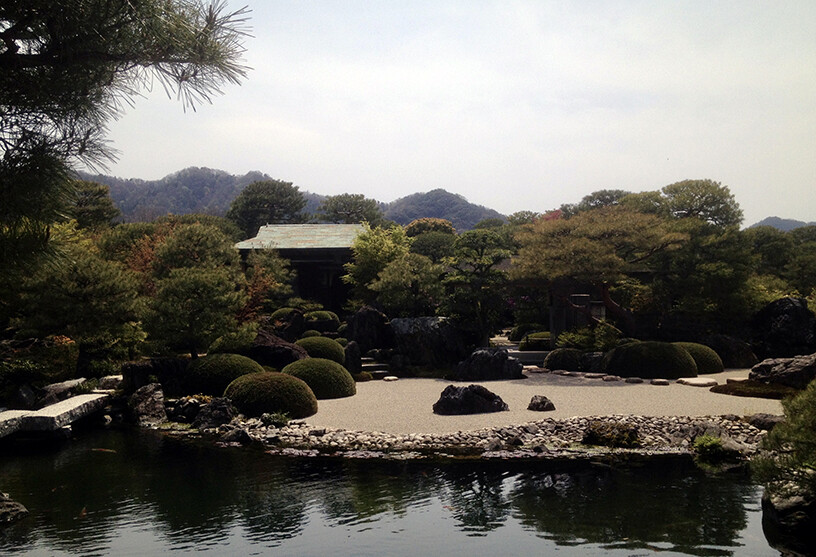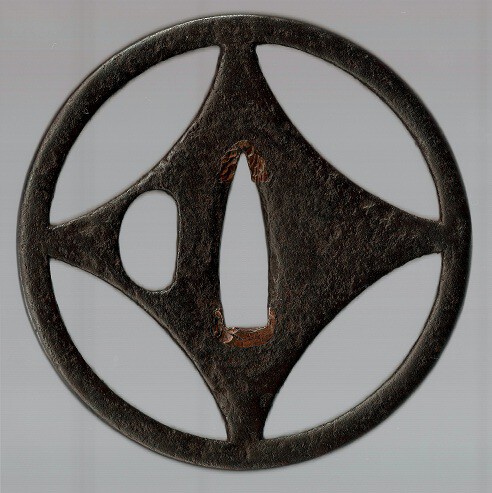-
Posts
2,875 -
Joined
-
Last visited
-
Days Won
3
Everything posted by Soshin
-
Hi Ford, Not sure what generation it is but in Rokusho Vol. 28 Tsuba The Japanese Sword Guards... page 15 a Funada Ikkin tsuba is discussed with detail photos. Hope you find the information helpful. Time to get to bed I need to go to work tomorrow. Yours truly, David Stiles
-
Hi Fred Geyer, Thanks for posting a photo of the Kaneie tsuba. I was lucky enough to attend the Tampa Show this year and was able to see a room full of wonderful masterpieces at the NBTHK/AB Nobuie talk. Being a member of the NBTHK all talks were free so I also attend the Nihonto talk as well. I do remember the single Kaneie masterpiece on the display table among the Nobuie tsuba. Speaking on the issue of plate thickness I think that this is a good attribution point to look for in Kaneie tsuba as well as other early pieces. I have a Yamakichibei tsuba with a unconfirmed mei which I will send in for shinsa shortly that also displays thinness measuring only 3.0 mm at rim and approximately (trouble measuring it) 2.0 mm at seppa-dai. The strength of the iron and the yakite (heat treatment) and tekkotsu displayed on the tsuba are remarkable. The Yamakichibei mei is heavy melted with only the yama kanji being clearly visible. I will be sure to post my pink paper of death once I get it back from the NBTHK. Or is the pink paper only with the NTHK. :lol: Yours truly, David Stiles
-
I really like the 鐔鑑賞記 by Zenzai blog. The examples provided are just wonderful for study. It really does not matter that much that the blog is in Japanese. Being a person who likes the Saga Kaneie school and collections pieces from that school looking at the 鐔鑑賞記 blog with the real Kaneie there really isn't any comparison. This is clear looking at the quality photos I can imagine having a really Kaneie tsuba in hand for comparison. Reflecting on this year when I was able to see some real (Shodai and Nidai) Nobuie tsuba in Feb. at the NBTHK presentation, a Nobuie masterpiece at the Tokyo Museum of Art in 2008, and also back in 2010 at the Art of the Samurai Expo at the Metropolitan Museum of Art in New York. Each time I was awestruck by the greatness of the Nobuie masterpieces. I feel that this awestruck amazement is also true for seeing in hand a real Kaneie masterpiece from either of the two masters. Just my two cents on the topic. Yours truly, David Stiles (Edit: Had to fix the years.)
-
Hi Martin, I downloaded the ZIP and looked at the image files. The tsuba nor the fuchi and gashira look Onin. I was thinking more along the lines of Mino Kinko work circa the Edo Period. I would prefer others peoples opinions as to what the work is as Kinko isn't my focus of tosogu collecting. You might what to post a few image as I am sure some people may not what to download a ZIP file to their computer. Just a suggestion. Yours truly, David Stiles
-
Hi Henry, I would agree but with the caveat that there are other schools in the Owari area that did produce similar iron. The Futogo Yama (二子山) school as well as the earlier Ono school being two of them. The specific design is also an important kantei point when dealing with Yagyu tsuba. Just my two cents. Yours truly, David Stiles
-
Hi Curran, Interesting that the NBTHK would paper a near identical tsuba to Yagyu. From looking at what little I have of notes taken from Yagyu family design book they did work with something that looks like the shippo-mon design done in sukashi. Do you remember the measurements of the tsuba was it about the same size? I am not really sure what this tsuba is so I might just submit it to shinsa. Here are my photos of rim. I hope they are helpful to the discussion. Yours truly, David Stiles
-
Hi Bob H., I was reading the PDF titled Using a Scanner for Photographing Small Items by Richard K. George from the NMB website. It recommend scanning items with the scanner cover completely open which will give the scan a darker background with better contrast. I scanned my tsuba with the scanner cover open and left the brightness and contrast at the default settings and setting the resolution high at 2400 dpi. The scanner I am using is a HP Deskjet F380 All-in-One Printer, Scanner, Copier. I also adjusted the color a bit using the Windows Live Photo Gallery software. I then re-sized image using Windows 7 Paint program to make it small enough to upload to the NMB webiste. I hope this answers your question. The scan really turned out nice. Hi Rob M., The Shippo-mon sukashi design is a really common design motif found in almost every tsuba school and I am sure some "country work" as well. I am sure the Bushu, Ito school has done this design before. The craftsmanship (i.e. how the common design is executed) is more important for attribution purposes when dealing with such a common design. Here is a link to an example of the same Shippo-mon sukashi design done with very different craftsmanship: http://www.aoi-art.com/fittings/tsuba/F11095.html. Notice the differences in color and texture of the iron, overall size and shape, and style of rim. Yours truly, David Stiles
-

Bridge of Dreams closes ;-(
Soshin replied to b.hennick's topic in Sword Shows, Events, Community News and Legislation Issues
Dear Craig, Sorry about all of your troubles as of late. I wish you best of luck in your future endeavor and dealing with the government's Social Security "red tape". Take care and hope to still see you around on the NMB. Yours truly, David Stiles -
In terms of the Bushu attribution for which I think Rob M. is referring to the Ito school located in Bushu during the Edo Period I really don't see attribution points which indicates this school. I was playing around with my computer's scanner and came up with this scan of the omote side. It should be helpful as there is no angle to the tsuba when it was scanned. Let me know what you think. Yours truly, David Stiles
-
Hi Henry, Thanks for taking the time to reply and discuss. Here is a photo per your request of the tsuba straight not at a angle from NMB member and fellow NBTHK member Grey D. who I purchased it from. Part of the reason I did that in the original photos was I just love the very complex texture and glossiness of the iron on the surface of the tsuba. In terms of age and attribution you might be right about Ko-Shoami. I don't think Shoami as I have some Edo Period Shoami pieces to compare it to and iron of this tsuba is considerably more heterogeneous with actives. The design of this tsuba is also more simplistic and refined. The design either Shippo or Itomaki (I have seen both Japanese terms for this design.) has a very nice refined antique appearance that I don't see in any Yagyu tsuba from the Edo Period. Looking forward to seeing other peoples impressions and ideas about this tsuba. Here is a quick edit showing a good example of Edo Period Shoami craftsmanship: http://www.nihonto.com/6.2.11.html. Notice the greater complexly of ji-sukashi design and the use of much more refined iron. Both are characteristics I have commonly seen in Edo Period Shoami school work. Yours truly, David Stiles
-
Recently purchased this tsuba as a possible Yagyu tsuba of the early Edo Period (circa 1615-1670). The following are the major kantei points for my attribution. The brownish-black iron has a grainy and glossy appearance to it. Lamination folds are very apparent on the surface of the tsuba as well as on the walls of the sukashi and kozuka and nakago hitsu-ana. The rim shows a fine granular concave tekkotsu (i.e. iron bones) as well. The size of the tsuba is large if it is a Yagyu tsuba at 7.7 cm diameter and is completely round. The thickness at the rim at 5 mm and 4 mm at the seppa-dai. The rim is square shaped (kaku-mimi) charactersitic of the Yagyu tsuba group. The Ji-sukashi design is called shippo(七寶) "seven treasures" a Buddhist motif for which I have observed variations of in notes of the Yagyu family tsuba design book. Below are the notes I was referring that I copied from Tsuba An Aesthetic Study by Dr. Torigoye and Robert E. Haynes. The overall shape is different but the ji-sukashi design is the same. I would like others opinions, comments, and questions about my analysis and the tsuba itself. I was talking to the tsuba original owner on Friday by telephone and he said that it could also be a Momoyama Period work of the Ono school of Owari province that would make along with other schools Yagyu tsuba in the Edo Period. I also noticed that his notes said it was a possible Bizen Suruga school work but the iron and the ji-shukashi design doesn't fit well with this school at least to the extent of my limited knowledge of that school's work. Yours truly, David Stiles
-
Hi Everyone, I just purchased this tsuba from Grey. :D I will be continuing the research of the Kanji (Chinese characters) on the surface of this tsuba. I am thinking the Kanji is likely something to do with Zen Buddhism as Daruma (Sanskrit: Bodhidharma) is the patriarch and transmitter of this type of Buddhism originally from Northern India, which has a specific focus on mediation practice. Zen Buddhism was transmitted from China to Japan three different times starting in the Kamakura Period up until as late as the Edo Period. These transmissions leading to the Rinzai, Soto, and Obaku branches of Zen Buddhism. With each transmission there was also a importation of Chinese ideas and language as Kanji characters. Once I have something I will be sure to post it here on this thread for discussion. Yours truly, David Stiles
-
Hi Jan, The tsuba looks to me to be a late Edo Period Nobuie copy. I would likely go on to say that the tsuba might have been made right after publication of some Nobuie tsuba oshigata during the late Edo Period. With that said it is a real antique Japanese tsuba. I hope you find the information helpful. Go ahead buy your friend a drink. Yours truly, David Stiles
-
Dear Edward F., I still think your tsuba to be considerably older in age and is a member of the Ko-Kinko group. I think you would notice some very significant differences if you had the Goto tsuba in hand to compare. The photo of the Goto tsuba is so poor I can't see much including the surface texture. Your tsuba has what I think are signs of lacquer being allied at some point in the distant past. This was a common practice of bushi before the Edo Period. To correct a minor technical point hot stamp were not used in soft metal alloy tsuba (i.e. kinko) only in iron tsuba. Stamp like design were often done with a special type of chisel and hammer. It is discussed in the following blog about a tsuba made by someone who trained with the late Edo Period Goto masters: http://kodogunosekai.com/2011/06/18/imai-nagatake-%E4%BB%8A%E4%BA%95%E6%B0%B8%E6%AD%A6%E3%80%80%E8%8A%B1%E6%8A%BC/. I hope you find the information helpful in your study. Yours truly, David Stiles
-
Would agree with Christian the tsuba is likely the work of the Saga Kaneie school. From looking at the low resolution photos I can make out a few parts of the mei. The Saga Kaneie school of the middle to late Edo Period (i.e 1700s and 1800s) always signed in the same manner as the second Kaneie master of the early Edo Period. A frequent subject was Chinese style landscapes with people. I hope you find the information helpful. I like the tsuba just wish you would post higher resolution photos. Yours truly, David Stiles
-
Hi Curt R., It is good that you didn't over pay for your first purchase. Given what it is its what I would consider a fair price. But be prepare to pay much more for a medium and high end menuki set. This is the right mindset to have starting out and it will allow you to go far. Just start by looking around for links section of this website and sales forum for a start. Even if you not ready to buy it will allow you to see what is out there in the international market. A final recombination is to attend one of the Japanese sword shows in the USA as it will give you a good opportunity to see what is out their and see many more menuki sets in hand without buying. I hope you find this information helpful. Yours truly, David Stiles
-
I would agree with Bob's analysis of the menuki in question. Overall not the worst first time purchase I have seen. I also like the Kyo-Kinko school as well. They often made good quality copies of the Goto school work during the Edo Period. Yours truly, David Stiles
-
Hi Elliott, Lets all relax because the weekend is almost here. :D I didn't think the above quote was intended topic of the thread. I was thinking that the topic of the tread was about a specific example of a fairly common Namban style cast iron copy. As a group Namban, Kanton, or Kagonami tsuba and the specific sub-classifications (Hizen, Nagasaki, etc.) are not made of cast iron. I have two Kanton style Namban tsuba in my collection one with a dealer paper and I can assure everyone that neither are made of cast iron but are made of forged iron with craved designs. I think this would be a great topic for discussion on the NMB Tosogu forum. I really like Bob Haynes and Torigoye ideas about a more detail classification of Namban tsuba group in Tsuba An Aesthetic Study. Yours truly, David Stiles
-
Hi John B., I hinted at this in some of my earlier posts about this tsuba. I don't think this tsuba is a product of the two great generations of Kaneie masters of Momoyama and early Edo Periods nor should it just be considered a gimei. I think it is a fairly good representation of the middle Edo Period Saga Kaneie school. Another common name for this school is the Tetsujin school. During the middle Edo period Kaneie style tsuba were very popular and some other schools including Umetada school started making tsuba in that style. The Saga Kaneie school unlike the Umetada school would always sign their tsuba using a mei style of the second Kaneie. Just my two cents. I hope you find the information helpful. Yours truly, David Stiles
-
I was hoping that Elliott, Lorenzo, Thomas, or David or others could provide a updated post SF Token Kai about what was discussed on the topic of cast Namban tsuba. I would love to know if any new facts or examples were uncovered. Thanks for taking the time to update the topic. Yours truly, David Stiles
-
This signature on the other side of the "nakago-ana" is bushu-ju (武州住). The tsuba is clearly a Chinese fake. The Kanji of the mei is better then most fake copies I have seen. Yours truly, David Stiles
-
I see in the first photo a poster for Ken's new book about WW2 Japanese Dirks. Having viewed some of his wonderful collection I sure the book is going to be a very good reference. Brian Snoddy's illustrations are wonderful of Japanese armor. Wish I could be there but their is always next year. Thanks for taking the time to post some photos of the show. Yours truly, David Stiles
-
Here is a link to another Umetada Shigenari tsuba signed in a similar way as mine clearly also done in a Edo Period Kaneie style: http://www.nihonto.us/UMETADA%20SHIGENARI%20TSUBA.htm. I find it interesting that Shigenari also sometimes used the name Narishige on his tsuba. I just wanted to add the additional information I found on the web. All of this evidence supports the suggestion that I have heard and read that during and after the sixth generation the Umetada school mostly did copies of other popular styles/schools of the time period including Kaneie, Shoami, and even the Echizen Kinai. Some Japanese experts suggest this was the result of later generations not having the ability to recreate many of the masterpieces produced by Umetada Myoju, Umetada Myoshin, or any of the other early masters of the school. See attached image of a Umetada tsuba I have done in a style similar to the Echizen Kinai school. Comments and questions always welcome. Yours truly, David Stiles
-
Thanks John B., The gold nunome-zogan style inlays on my tsuba were a bit worn off on the omote side due to rust pitting that have since been removed by the tsuba former owner. The ura side has the gold nunome-zogan style inlays in better condition. Your tsuba inlays all seems to be in good condition. Here is a scan of a similar tsuba to mine from the NBTHK Token-Bijutsu monthly magazine issue number 636. Notice the great similarly in the workmanship of the waves and the use of gold nunome-zogan style inlays. The signature is very good match as well in terms of how Umetada Shigenari (埋忠重成) Kanji is carved. As well as how the nakago-ana is finished is similar. Yours truly, David Stiles











